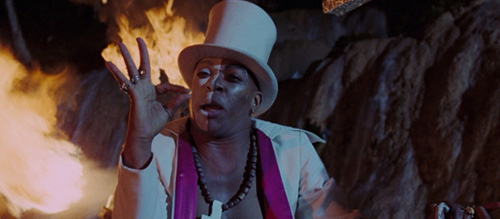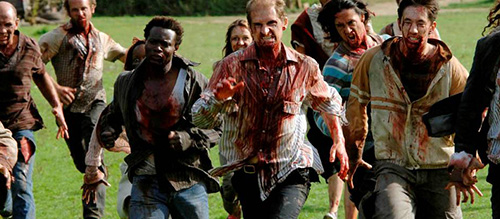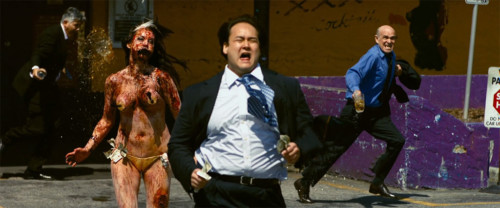The History of Zombies in Cinema
This article was written exclusively for The Film Magazine by Rhian Gillah.
It’s hard to remember exactly where the concept of zombies originated when the idea has taken its own form and stumbled into different sub-categories of… what exactly a zombie is, how they’re created, what they do, how to kill them, and so on. We all know humans can devolve into a zombie through a virus outbreak like in 28 Days Later (Boyle, 2002), or from the radiation of an atomic bomb, an alien invasion, a green syringe of glowing gunge like in Re-Animator (Gordon, 1985), or voodoo…
Voodoo is the idea we thank for giving us these slow moving, brain eating monsters we’ve grown to love shooting in the head.
An initial sighting of what we now associate with being as a zombie can be recorded in I Walked With A Zombie (Tourneur, 1943), and was commonly recognised as a tall, muscular, glassy eyed, black man formed using Haitian Voodoo. This was taken from the idea of Baron Samedi, master of the dead, a spirit who can be summoned by a Houngan (voodoo priest). You may recognise Baron Samedi in the James Bond film Live And Let Die (Hamilton, 1973) depicted by Geoffrey Holder.
Live and Let Die (1973)
John Landis claims in his 2011 book “Monsters in the Movies” that “In Haitian Voodoo, a houngan uses poisons and ritual burials to convince victims that they are dead. The houngan then uses their new zombies to pick sugar cane and for other menial tasks. Many claim that this practise continues today. In Voodoo and in the movies, zombies are symbols of exploitation and social decay” (Landis, 2011 – pg. 93). The first appearance of an on-screen zombie actually starred in White Zombie (Halperin, 1932) with the same concept; Haitian voodoo used to create sugar cane slaves. Fun fact: in Haitian, ‘zombi’ means ‘spirit of the dead’.
A similar theme runs through to the 1960s with Hammer’s film The Plague Of The Zombies (Gilling, 1966) where the zombies are created (through witchcraft) for slavery or to be soldiers. Back in the day, zombies were manipulated by higher beings, but as time has moved on, the controlled chaos of zombies has become less controlled, causing apocalyptic level pandemonium.
The 1960s and 70s are where eating the flesh of the living (specifically the brains) became popularised. Zombies were no longer slaves, but rather dangerous, hungry, slimy uncivilised versions of our selves, though often slightly comical. They were the common subject of most grindhouse B-movies, like in Rodriguez’s 2007 homage Planet Terror. Landis points out their comedic side is evident in Return Of The Living Dead (O’Bannon, 1985), a movie in which the zombies can speak. “A police car is surrounded by hungry zombies who viciously attack the two cops inside and then gleefully eat their brains. The patrol car’s radio crackles and a voice asks if they need assistance. One of the zombies clumsily takes the microphone and croaks “send more cops”. (Landis, 2011 – pg. 94). They even start to run in Danny Boyle’s 2002 picture 28 Days Later.
28 Days Later (2002)
“In contemporary films, zombies are frequently agents of anarchy and represent the collapse of an orderly society” (Landis, 2011 – pg. 94), and thus it’s every man for himself in these high intensity, heart pounding flicks. Modern zombie classics such as Zombieland (Fleischer, 2009), 28 Days Later (Boyle, 2002), 28 Weeks Later (Fresnadillo, 2007) and Shaun Of The Dead (Wright, 2004) all take the form of George A. Romero’s original ‘every man for himself, havoc and chaos’ classic, mothership of a zombie movie: Night Of The Living Dead (Romero, 1968). Margo Smith says in her article “The Evolution Of Zombie Cinema” that “Night of the Living Dead was the quintessential, classic zombie film that most future zombie films would be modelled after”(Smith, 2018). The structure of which goes; zombie outbreak starts, unleash chaos onto the streets, group of survivors band together, until each is picked off one by one… George A. Romero is the daddy of zombie flicks, with other films such as Dawn Of The Dead (1978), Day Of The Dead (1985) and Land Of The Dead (2005). “This was also the start of the traditionally slow moving, brain-dead like monster who can be destroyed by a blow to the head” (Smith, 2018).
By the 21st century, the zombie had become a semiotic icon, a creature to be idealised for its imperfections as well as greatly feared for them. This establishment was recognised by directors like Edgar Wright, Ruben Fleischer and Jonathan Levine (just to name a few) with their movies Shaun Of The Dead (Wright, 2004), Zombieland (Fleischer, 2009) and Warm Bodies (Levine, 2013). They had recognised the structure of a zombie flick was extremely well known and popular but needed a bit of edge to keep it popularised, so comedic elements were introduced to the world of zombie horror. This had been already been done with other horror sub-genres, but Zomcoms arguably do it the best.
Zombieland (2009)
Zombies are popular in every culture. A zombie is something that is universally recognised and appreciated. John Landis lists zombie movies from around the world, for any ‘die-hard’ fans out there – “The Spanish zombies in Rec (Jaume Balaguero, Paco Plaza, 2007), or the British zombies in Shaun Of The Dead (Edgar Wright, 2004) and 28 Days Later (Danny Boyle, 2002), or the French zombies in Paris By Night Of The Living Dead (Gregory Morin, 2009) and La Horde (Yannick Dahan, Benjamin Rocher, 2009), the New Zealand zombies in Peter Jackson’s Dead Alive (aka Braindead, 1992), and all those Italian zombies from Michele Soavi’s Dellamorte Dellamore (aka Cemetery Man, 1994) to Lucio Fulci’s Zombi 2 (1979) to the Japanese (I swear this is a real name) Big Tits Zombie (Takao Nakano, 2010) to the all-American Zombie Strippers (Jay Lee, 2008). I think we can safely say that zombies are an international audience favourite”. (Landis, 2011) pg. 93 – 94.
From voodoo magic, all the way up to virus outbreaks, zombies have evolved over time, but will always be the hordes of hungry, drooling, rotting corpses we know and love. And they love us too, for you know, it’s whats on the inside that counts.
Written by Rhian Gillah
References:
Landis, J. (2011). Monsters in the Movies: 100 Years of Cinematic Nightmares. Dorling Kindersley Limited.
Smith, M. (2018). The Evolution of Zombie Cinema. Available from: https:// moviesdrop.com/evolution-of-zombie-cinema/3785/
You can support Rhian Gillah’s make-up and hair service at the following links:
Facebook – Snake Eyes SFX
Instagram – @snakeeyessfx




